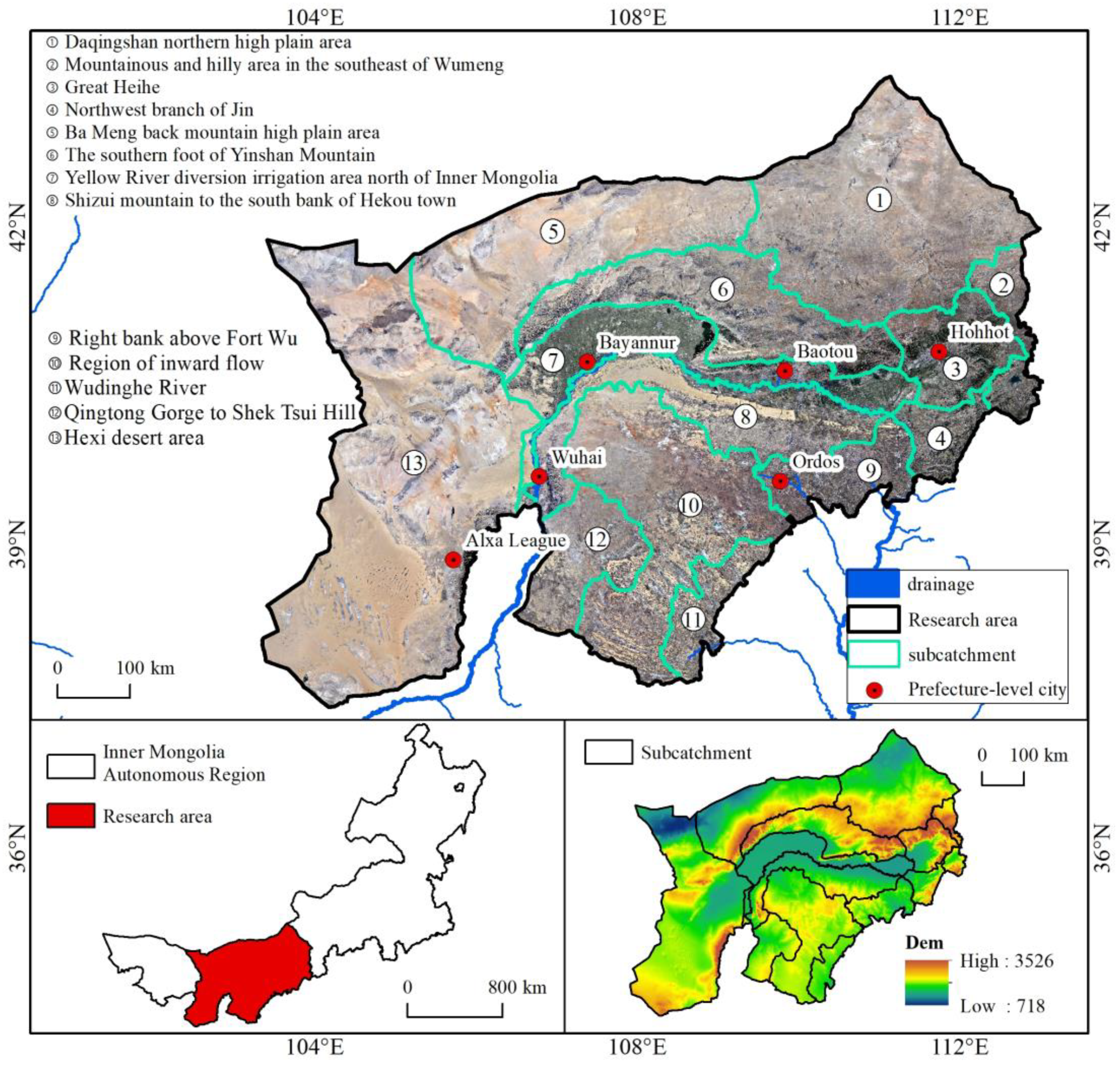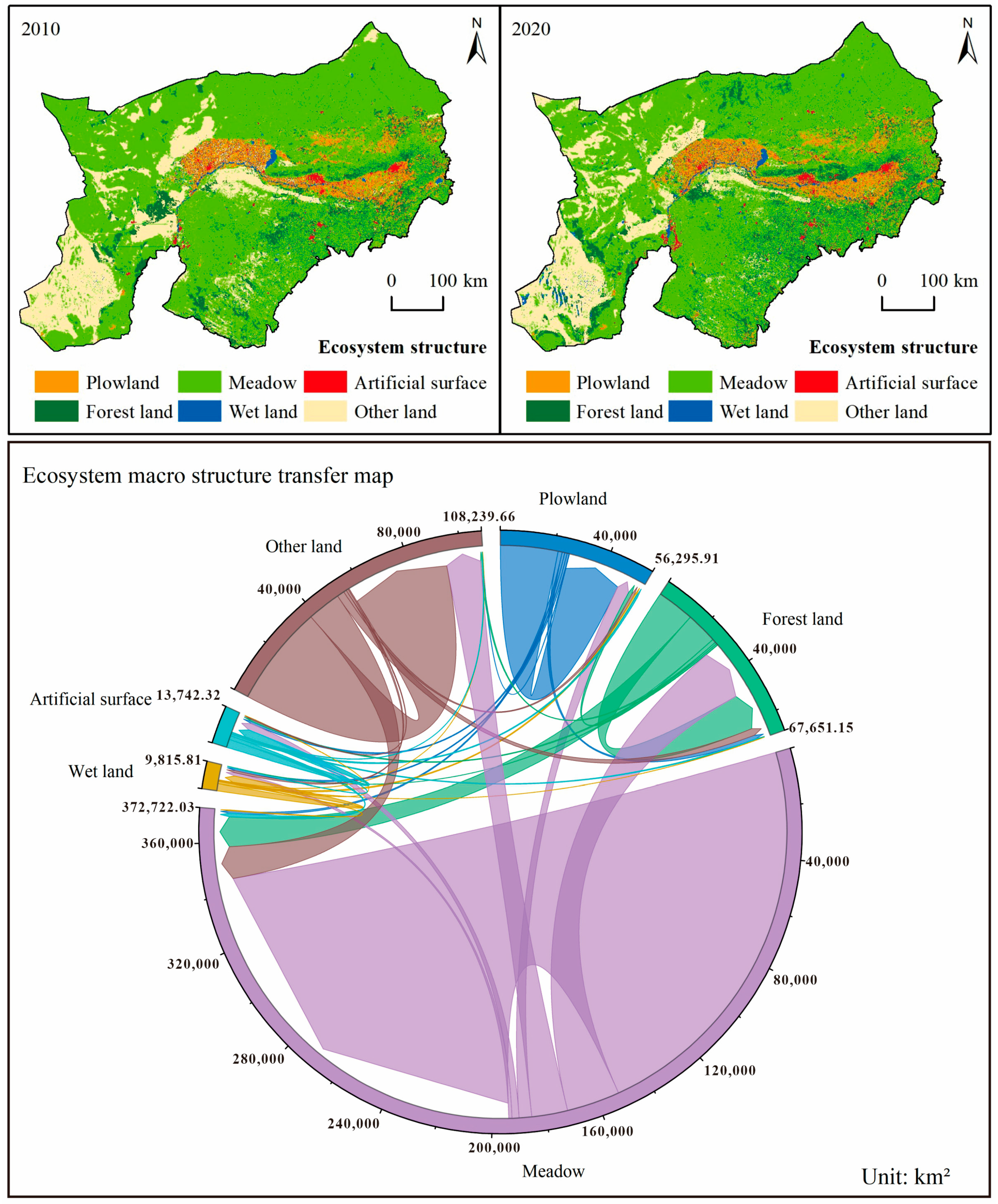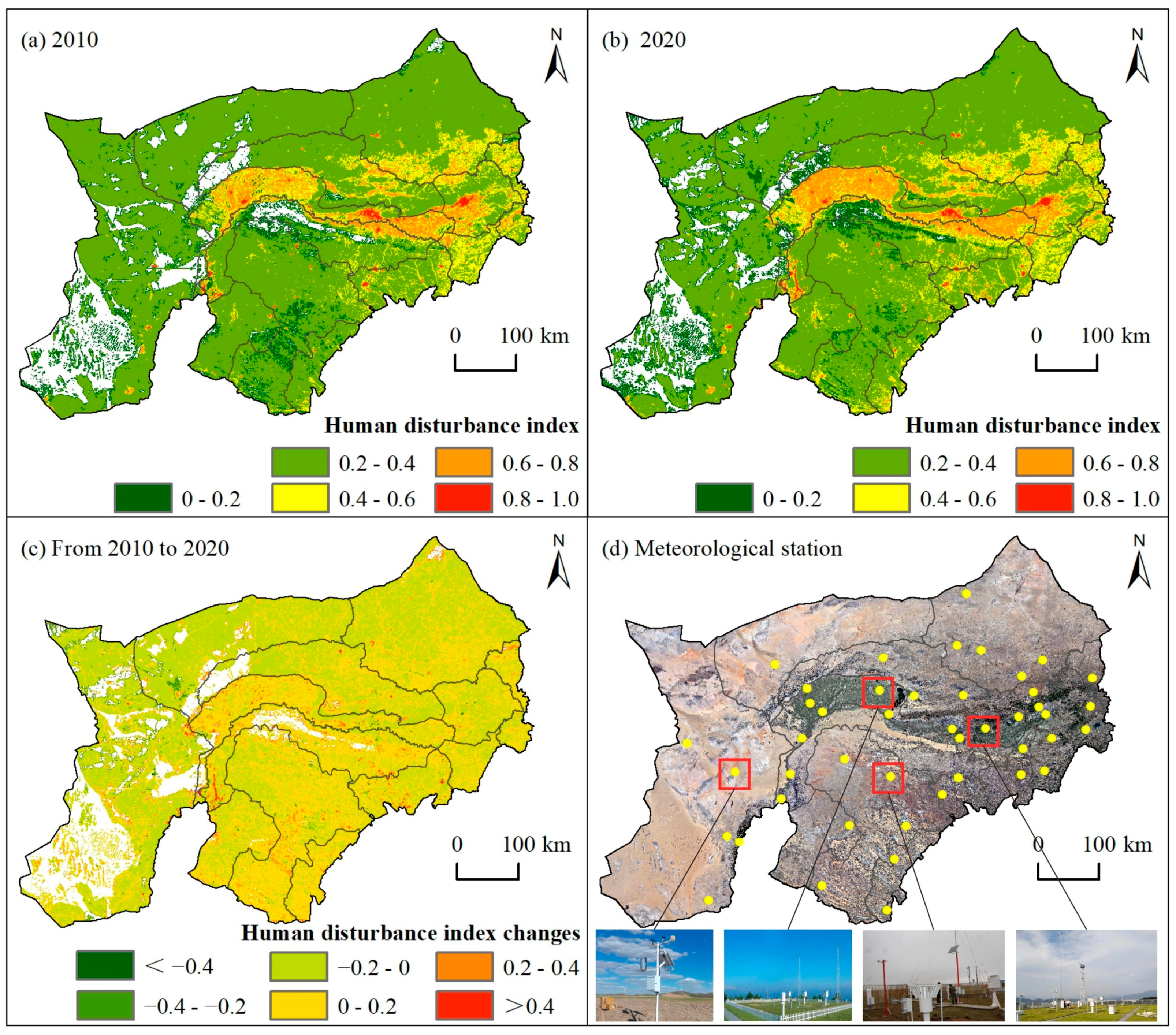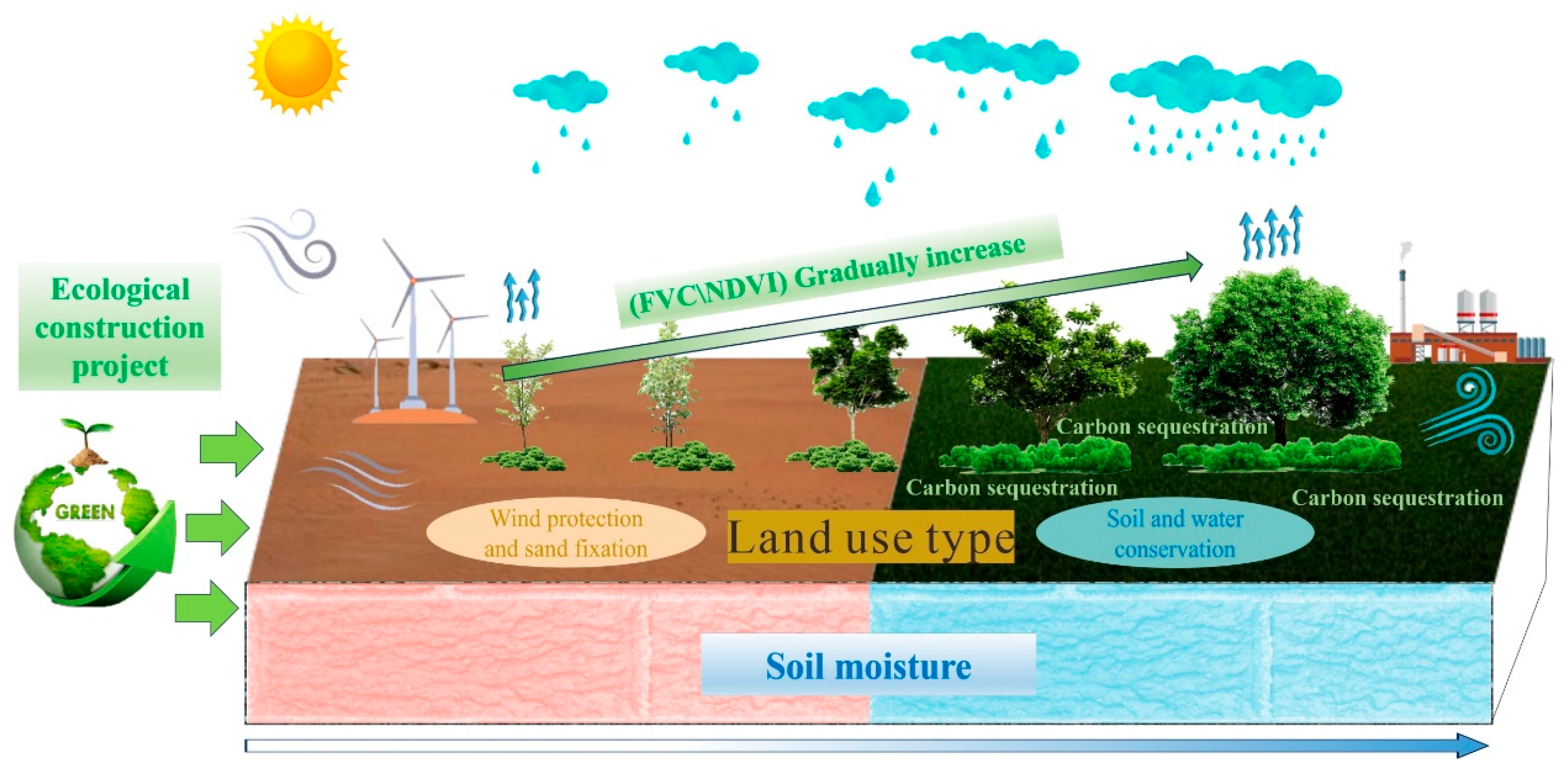Temporal and Spatial Variation Characteristics of the Ecosystem in the Inner Mongolia Section of the Yellow River Basin
Abstract
:1. Introduction
2. Materials and Methods
2.1. Study Area
2.2. Data Sources (Table 1)
| Data Type | Spatial Scale | Temporal Resolution | Format |
|---|---|---|---|
| Land Use/Cover Data | 1:100,000 m | a | Shapefile |
| Imagery | 2~15 m | d | Raster |
| Meteorological Data | 44 Monitoring Sites | d | Txt |
| DEM | 30 m | - | Raster |
| NDVI | 30 m | 8d | Raster |
| Basic Geographic Data | 1:250,000 m | - | Shapefile |
2.3. Ecosystem Types and Spatiotemporal Change Analysis
2.4. Ecosystem Quality and Spatiotemporal Change Analysis
2.5. Ecosystem Service Change Analysis
2.5.1. Wind Prevention and Sand Fixation
2.5.2. Soil Retention
2.6. Analysis of the Driving Force Factors
3. Results
3.1. Ecosystem Macrostructure and Changes
3.2. Ecosystem Quality and Changes
3.3. Analysis of Key Ecosystem Services and Changes
3.4. Analysis of Drivers of Ecosystem Changes
4. Discussion
4.1. Ecosystem Quantity and Variation
4.2. Ecosystem Quality and Change
4.3. Ecosystem Key Services and Changes
4.4. Ecosystem Change Drivers
5. Conclusions
Author Contributions
Funding
Institutional Review Board Statement
Informed Consent Statement
Data Availability Statement
Acknowledgments
Conflicts of Interest
References
- Gao, L.; Bryan, B.A. Finding Pathways to National-Scale Land-Sector Sustainability. Nature 2017, 544, 217–222. [Google Scholar] [CrossRef]
- Mirzabaev, A.; Wuepper, D. Economics of Ecosystem Restoration. Annu. Rev. Resour. Econ. 2023, 15, 329–350. [Google Scholar] [CrossRef]
- Vignieri, S. The Benefits of Ecosystem Restoration. Science 2020, 368, 1201–1203. [Google Scholar] [CrossRef]
- Xin, Y.; Liu, X. Coupling Driving Factors of Eco-Environmental Protection and High-Quality Development in the Yellow River Basin. Front. Environ. Sci. 2022, 10, 951218. [Google Scholar] [CrossRef]
- Bai, X.; Zhang, Z.; Li, Z.; Zhang, J. Spatial Heterogeneity and Formation Mechanism of Eco-Environmental Quality in the Yellow River Basin. Sustainability 2023, 15, 10878. [Google Scholar] [CrossRef]
- Chi, W.; Wang, Y.; Dang, X.; Wu, X.; Luo, Q. Temporal Variation and Spatial Pattern of Soil Erosion in the Yellow River Basin. J. Desert Res. 2023, 43, 305–317. [Google Scholar]
- Qiu, M.; Zuo, Q.; Wu, Q.; Yang, Z.; Zhang, J. Water Ecological Security Assessment and Spatial Autocorrelation Analysis of Prefectural Regions Involved in the Yellow River Basin. Sci. Rep. 2022, 12, 5105. [Google Scholar] [CrossRef] [PubMed]
- Chen, F.; Huang, H.; Yang, G.; Li, X. Research on the Dynamic Change of the Ecological Environment and Its Influencing Factors in the Yellow River Basin Based on Remote Sensing Ecological Index. J. Desert Res. 2023, 43, 252–262. [Google Scholar]
- Hou, Y.; Xie, Z.; Tian, Y.; Jiang, J.; Liang, Y.; Wang, Q.; Fang, Q.; Xu, T.; Zhang, Y.; Li, H.; et al. Evolution Trend of Water Quality in the Lnner Mongolia Section of the Yellow River from 2003 to 2020. Environ. Sci. 2023, 1–12. [Google Scholar] [CrossRef]
- Gao, W.; Zhang, S.; Rao, X.; Lin, X.; Li, R. Landsat TM/OLI-Based Ecological and Environmental Quality Survey of Yellow River Basin, Inner Mongolia Section. Remote Sens. 2021, 13, 4477. [Google Scholar] [CrossRef]
- Li, T.; Zhang, Q.; Wang, G.; Singh, V.P.; Zhao, J.; Sun, S.; Wang, D.; Liu, T.; Duan, L. Ecological Degradation in the Inner Mongolia Reach of the Yellow River Basin, China: Spatiotemporal Patterns and Driving Factors. Ecol. Indic. 2023, 154, 110498. [Google Scholar] [CrossRef]
- Xu, J.; Wang, H.; Zhao, K.; Li, Z. Evaluation of Provincial Carbon-Neutral Capacities in the Yellow River Basin Using DPSIR. Sci. Rep. 2022, 12, 18180. [Google Scholar] [CrossRef] [PubMed]
- Tian, M.; Feng, C.; Wang, S.; Tian, Y.; Niu, X. Ecological Restoration of the Yellow River Basin in the Last 70 Years and Systematic Restoration Thinking. J. Environ. Eng. Technol. 2023, 13, 1787–1797. [Google Scholar] [CrossRef]
- Feng, X.; Fu, B.; Piao, S.; Wang, S.; Ciais, P.; Zeng, Z.; Lü, Y.; Zeng, Y.; Li, Y.; Jiang, X.; et al. Revegetation in China’s Loess Plateau Is Approaching Sustainable Water Resource Limits. Nat. Clim. Chang. 2016, 6, 1019–1022. [Google Scholar] [CrossRef]
- Bryan, B.A.; Gao, L.; Ye, Y.; Sun, X.; Connor, J.D.; Crossman, N.D.; Stafford-Smith, M.; Wu, J.; He, C.; Yu, D.; et al. China’s Response to a National Land-System Sustainability Emergency. Nature 2018, 559, 193–204. [Google Scholar] [CrossRef] [PubMed]
- Deng, X.; Hu, S.; Zhan, C. Attribution of Vegetation Coverage Change to Climate Change and Human Activities Based on the Geographic Detectors in the Yellow River Basin, China. Environ. Sci. Pollut. Res. Int. 2022, 29, 44693–44708. [Google Scholar] [CrossRef] [PubMed]
- Liu, T.; Zhang, Q.; Li, T.; Zhang, K. Dynamic Vegetation Responses to Climate and Land Use Changes over the Inner Mongolia Reach of the Yellow River Basin, China. Remote Sens. 2023, 15, 3531. [Google Scholar] [CrossRef]
- Zhang, X.; Wang, G.; Xue, B.; Wang, Y.; Wang, L. Spatiotemporal Variation of Evapotranspiration on Different Land Use/Cover in the Inner Mongolia Reach of the Yellow River Basin. Remote Sens. 2022, 14, 4499. [Google Scholar] [CrossRef]
- Jiang, X.; Wang, G.; Wang, Y.; Yao, J.; Xue, B.; A, Y. A Hybrid Framework for Simulating Actual Evapotranspiration in Data-Deficient Areas: A Case Study of the Inner Mongolia Section of the Yellow River Basin. Remote Sens. 2023, 15, 2234. [Google Scholar] [CrossRef]
- Hu, H.; Tian, G.; Wu, Z.; Xia, Q. Cross-Regional Ecological Compensation under the Composite Index of Water Quality and Quantity: A Case Study of the Yellow River Basin. Environ. Res. 2023, 238, 117152. [Google Scholar] [CrossRef]
- Yun, J.; Liu, H.; Xu, Z.; Cao, X.; Ma, L.; Wen, L.; Zhuo, Y.; Wang, L. Assessing Changes in the Landscape Pattern of Wetlands and Its Impact on the Value of Wetland Ecosystem Services in the Yellow River Basin, Inner Mongolia. Sustainability 2022, 14, 6328. [Google Scholar] [CrossRef]
- Zhang, H.; Zhang, J.; Lv, Z.; Yao, L.; Zhang, N.; Zhang, Q. Spatio-Temporal Assessment of Landscape Ecological Risk and Associated Drivers: A Case Study of the Yellow River Basin in Inner Mongolia. Land 2023, 12, 1114. [Google Scholar] [CrossRef]
- Potter, C.S.; Randerson, J.T.; Field, C.B.; Matson, P.A.; Vitousek, P.M.; Mooney, H.A.; Klooster, S.A. Terrestrial Ecosystem Production: A Process Model Based on Global Satellite and Surface Data. Glob. Biogeochem. Cycles 1993, 7, 811–841. [Google Scholar] [CrossRef]
- Chi, W.; Zhao, Y.; Kuang, W.; He, H. Impacts of Anthropogenic Land Use/Cover Changes on Soil Wind Erosion in China. Sci. Total Environ. 2019, 668, 204–215. [Google Scholar] [CrossRef] [PubMed]
- Fryrear, D.W.; Krammes, C.A.; Williamson, D.L.; Zobeck, T.M. Computing the Wind Erodible Fraction of Soils. J. Soil Water Conserv. 1994, 49, 183–188. [Google Scholar]
- Zhang, W.; Xie, Y.; Liu, B. Rainfall Erosivity Estimation Using Daily Rainfall Amounts. Sci. Geogr. Sin. 2002, 22, 705–711. [Google Scholar]
- McCool, D.K.; Foster, G.R.; Mutchler, C.K.; Meyer, L.D. Revised Slope Length Factor for the Universal Soil Loss Equation. Trans. ASAE 1989, 32, 1571–1576. [Google Scholar] [CrossRef]
- Cai, C.; Ding, S.; Shi, Z.; Huang, L.; Zhang, G. Study of Applying USLE and Geographical Information System lDRlSl to Predict Soil Erosion in Small Watershed. J. Soil Water Conserv. 2000, 2, 19–24. [Google Scholar] [CrossRef]
- Ren, S.; Li, Y.; Peichl, M. Diverse Effects of Climate at Different Times on Grassland Phenology in Mid-Latitude of the Northern Hemisphere. Ecol. Indic. 2020, 113, 106260. [Google Scholar] [CrossRef]
- Zhao, G.; Liu, J.; Kuang, W.; Ouyang, Z.; Xie, Z. Disturbance Impacts of Land Use Change on Biodiversity Conservation Priority Areas across China: 1990–2010. J. Geogr. Sci. 2015, 25, 515–529. [Google Scholar] [CrossRef]
- Wu, C.; Chen, B.; Huang, X.; Dennis Wei, Y.H. Effect of Land-Use Change and Optimization on the Ecosystem Service Values of Jiangsu Province, China. Ecol. Indic. 2020, 117, 106507. [Google Scholar] [CrossRef]
- Yuan, Y.; Wang, M.; Zhu, Y.; Huang, X.; Xiong, X. Urbanization’s Effects on the Urban-Rural Income Gap in China: A Meta-Regression Analysis. Land Use Policy 2020, 99, 104995. [Google Scholar] [CrossRef]
- Fang, J.; Xiong, K.; Chi, Y.; Song, S.; He, C.; He, S. Research Advancement in Grassland Ecosystem Vulnerability and Ecological Resilience and Its Inspiration for Improving Grassland Ecosystem Services in the Karst Desertification Control. Plants 2022, 11, 1290. [Google Scholar] [CrossRef]
- Nandintsetseg, B.; Boldgiv, B.; Chang, J.; Ciais, P.; Davaanyam, E.; Batbold, A.; Bat-Oyun, T.; Stenseth, N.C. Risk and Vulnerability of Mongolian Grasslands under Climate Change. Environ. Res. Lett. 2021, 16, 034035. [Google Scholar] [CrossRef]
- Yang, S.; Hao, Q.; Liu, H.; Zhang, X.; Yu, C.; Yang, X.; Xia, S.; Yang, W.; Li, J.; Song, Z. Impact of Grassland Degradation on the Distribution and Bioavailability of Soil Silicon: Implications for the Si Cycle in Grasslands. Sci. Total Environ. 2019, 657, 811–818. [Google Scholar] [CrossRef]
- Bardgett, R.D.; Bullock, J.M.; Lavorel, S.; Manning, P.; Schaffner, U.; Ostle, N.; Chomel, M.; Durigan, G.; Fry, E.L.; Johnson, D.; et al. Combatting Global Grassland Degradation. Nat. Rev. Earth Environ. 2021, 2, 720–735. [Google Scholar] [CrossRef]
- Chi, W.; Wang, Y.; Lou, Y.; Na, Y.; Luo, Q. Effect of Land Use/Cover Change on Soil Wind Erosion in the Yellow River Basin since the 1990s. Sustainability 2022, 14, 12930. [Google Scholar] [CrossRef]
- Zhao, H.; Feng, S.; Dang, X.; Meng, Z.; Chen, Z.; Gao, Y. Wind Regime and Sand Transport in the Mid-Course of Ten Tributaries of the Yellow River, Inner Mongolia of China. Front. Environ. Sci. 2023, 11, 123392. [Google Scholar] [CrossRef]
- Tian, T.; Yang, Z.; Guo, J.; Zhang, T.; Wang, Z.; Miao, P. Spatiotemporal Evolution of Soil Erosion and Its Driving Mechanism in the Mongolian Section of the Yellow River Basin. Land 2023, 12, 801. [Google Scholar] [CrossRef]
- Xie, J.; Lu, Z.; Xiao, S.; Yan, C. The Latest Desertification Process and Its Driving Force in Alxa League from 2000 to 2020. Remote Sens. 2023, 15, 4867. [Google Scholar] [CrossRef]
- Tseng, S.-W. Analysis of Energy-Related Carbon Emissions in Inner Mongolia, China. Sustainability 2019, 11, 7008. [Google Scholar] [CrossRef]






| Category | Natural Unutilized | Naturally Regenerated | Anthropogenically Regenerated | Anthropogenic Non-Renewable |
|---|---|---|---|---|
| Ecosystem Type | Other land | Forest Land, meadow, wetland | Plowland | Artificial surface |
| Disturbance Grading Index | 0 | 1 | 2 | 3 |
| Year | Statistical Indicator | Forest Land | Meadow | Wetland | Plowland | Artificial Surface | Other Land |
|---|---|---|---|---|---|---|---|
| 2010 | Area (km2) | 28,469.52 | 192,236.68 | 3669.90 | 25,070.00 | 5905.01 | 54,606.32 |
| Proportion (%) | 9.18% | 62.02% | 1.18% | 8.09% | 1.91% | 17.62% | |
| 2020 | Area (km2) | 38,857.36 | 177,690.01 | 2176.98 | 29,568.01 | 8868.52 | 52,186.76 |
| Proportion (%) | 12.56% | 57.44% | 0.70% | 9.56% | 2.87% | 16.87% |
| Type (2010) | Type (2020) | |||||
|---|---|---|---|---|---|---|
| Forest Land (km2) | Meadow (km2) | Wetland (km2) | Plowland (km2) | Artificial Surface (km2) | Other Land (km2) | |
| Forest Land | 14,477.20 | 11,687.93 | 117.40 | 1220.10 | 516.83 | 621.66 |
| Meadow | 19,877.41 | 152,429.16 | 1160.33 | 4304.77 | 2486.26 | 13,205.27 |
| Wetland | 66.89 | 265.28 | 2966.5 | 509.93 | 164.59 | 509.93 |
| Plowland | 1409.02 | 392.28 | 544.61 | 22,653.76 | 691.21 | 96.02 |
| Artificial Surface | 375.63 | 1321.57 | 160.29 | 483.85 | 3118.43 | 184.24 |
| Other Land | 2774.61 | 12,420.66 | 805.63 | 1012.85 | 385.22 | 37,919.59 |
| Basin/Sub-Region | NDVI | FVC | NPP | |||
|---|---|---|---|---|---|---|
| Average | Slope | Average % | Slope (% a−1) | Average | Slope | |
| Northwest Shanxi Tributary | 0.51 | 0.009 | 54.46 | 0.010 | 137.57 | 6.045 |
| Hexi Desert Region | 0.13 | 0.002 | 5.04 | 0.002 | 2.50 | 0.087 |
| Endorheic Area | 0.29 | 0.005 | 26.03 | 0.005 | 45.68 | 1.929 |
| Wuding River | 0.34 | 0.007 | 33.12 | 0.008 | 67.56 | 3.430 |
| Qingtongxia to Shizuishan | 0.28 | 0.005 | 24.55 | 0.006 | 39.64 | 1.623 |
| Shizuishan to Hekouzhen Southern Bank | 0.29 | 0.005 | 25.69 | 0.006 | 43.76 | 1.831 |
| North Yellow River Diversion Irrigation Area in Inner Mongolia | 0.51 | 0.006 | 54.80 | 0.007 | 103.37 | 2.605 |
| Yinshan Southern Foothills | 0.30 | 0.004 | 27.49 | 0.004 | 53.41 | 1.612 |
| Dahei River | 0.57 | 0.007 | 62.42 | 0.007 | 187.52 | 5.697 |
| Bayan Nur Mountain High Plateau | 0.14 | 0.001 | 6.98 | 0.001 | 2.50 | 0.072 |
| Northern Daqing Mountain High Plateau | 0.28 | 0.004 | 24.90 | 0.004 | 45.13 | 1.430 |
| Ulanqab Southeastern Mountain and Hill Area | 0.50 | 0.006 | 53.31 | 0.006 | 145.36 | 4.725 |
| Above Wubao Right Bank | 0.41 | 0.010 | 41.43 | 0.012 | 84.40 | 4.677 |
| Overall Average | 0.27 | 0.004 | 23.42 | 0.004 | 44.36 | 1.577 |
| Basin/Sub-Region | Unit Area Wind Erosion Modulus | Wind Erosion | Unit Area Water Erosion Modulus | Actual Water Erosion | ||
|---|---|---|---|---|---|---|
| Average | Slope | (10,000 tons) | Average | Slope | (10,000 tons) | |
| Northwest Shanxi Tributary | 0.45 | −0.034 | 24.62 | 1585.86 | −44.430 | 86,672.44 |
| Hexi Desert Region | 74.09 | −3.511 | 58,319.58 | 178.31 | 0.098 | 140,361.30 |
| Endorheic Area | 16.79 | −0.611 | 6281.72 | 177.45 | 0.525 | 66,408.47 |
| Wuding River | 6.12 | −0.152 | 447.39 | 102.04 | −1.010 | 7459.77 |
| Qingtongxia to Shizuishan | 6.35 | −0.365 | 792.87 | 159.13 | 2.073 | 19,858.04 |
| Shizuishan to Hekouzhen Southern Bank | 44.25 | −1.464 | 9367.30 | 656.33 | −1.770 | 138,925.75 |
| North Yellow River Diversion Irrigation Area in Inner Mongolia | 36.43 | −1.566 | 7483.84 | 296.51 | −5.112 | 60,912.55 |
| Yinshan Southern Foothills | 11.97 | −0.468 | 2923.69 | 895.17 | −2.955 | 218,639.03 |
| Dahei River | 1.91 | −0.052 | 210.61 | 594.23 | −11.153 | 65,559.37 |
| Bayan Nur Mountain High Plateau | 88.51 | −3.335 | 30,341.62 | 234.97 | 0.579 | 80,550.20 |
| Northern Daqing Mountain High Plateau | 16.27 | −0.661 | 7139.57 | 248.11 | −0.806 | 108,875.08 |
| Ulanqab Southeastern Mountain and Hill Area | 2.95 | −0.068 | 181.05 | 634.21 | −7.868 | 38,856.92 |
| Above Wubao Right Bank | 1.03 | −0.059 | 105.25 | 1145.70 | −26.655 | 116,655.48 |
| Overall Average | 39.48 | −1.675 | 961,414.81 | 367.25 | −2.774 | 1,149,623.36 |
| Basin/Sub-Region | Human Disturbance Index | Temperature (°C) | Precipitation (mm) | ||||
|---|---|---|---|---|---|---|---|
| 2010 | 2020 | Change | Average | Slope | Average | Slope | |
| Northwest Shanxi Tributary | 0.439 | 0.442 | 0.002 | 5.815 | 0.022 | 373.896 | 3.562 |
| Hexi Desert Region | 0.207 | 0.194 | −0.013 | 8.603 | 0.020 | 139.581 | 1.191 |
| Endorheic Area | 0.292 | 0.323 | 0.030 | 7.730 | 0.018 | 303.171 | 2.762 |
| Wuding River | 0.322 | 0.354 | 0.032 | 8.336 | 0.012 | 382.075 | 3.112 |
| Qingtongxia to Shizuishan | 0.310 | 0.333 | 0.024 | 8.269 | 0.012 | 263.458 | 2.660 |
| Shizuishan to Hekouzhen Southern Bank | 0.317 | 0.364 | 0.047 | 7.428 | 0.023 | 271.544 | 2.902 |
| North Yellow River Diversion Irrigation Area in Inner Mongolia | 0.501 | 0.547 | 0.047 | 7.617 | 0.026 | 214.178 | 2.602 |
| Yinshan Southern Foothills | 0.330 | 0.343 | 0.013 | 5.302 | 0.028 | 251.711 | 3.284 |
| Dahei River | 0.466 | 0.469 | 0.003 | 4.538 | 0.027 | 313.512 | 3.225 |
| Bayan Nur Mountain High Plateau | 0.291 | 0.293 | 0.002 | 6.797 | 0.029 | 137.118 | 1.785 |
| Northern Daqing Mountain High Plateau | 0.359 | 0.368 | 0.009 | 4.902 | 0.027 | 217.564 | 3.217 |
| Ulanqab Southeastern Mountain and Hill Area | 0.430 | 0.449 | 0.019 | 4.165 | 0.024 | 326.407 | 2.709 |
| Above Wubao Right Bank | 0.383 | 0.402 | 0.019 | 7.109 | 0.026 | 390.385 | 3.865 |
| Overall Average | 0.312 | 0.324 | 0.012 | 7.014 | 0.023 | 224.751 | 2.426 |
Disclaimer/Publisher’s Note: The statements, opinions and data contained in all publications are solely those of the individual author(s) and contributor(s) and not of MDPI and/or the editor(s). MDPI and/or the editor(s) disclaim responsibility for any injury to people or property resulting from any ideas, methods, instructions or products referred to in the content. |
© 2024 by the authors. Licensee MDPI, Basel, Switzerland. This article is an open access article distributed under the terms and conditions of the Creative Commons Attribution (CC BY) license (https://creativecommons.org/licenses/by/4.0/).
Share and Cite
Yang, J.; Jia, L.; Hao, J.; Luo, Q.; Chi, W.; Wang, Y.; Zheng, H.; Yuan, R.; Na, Y. Temporal and Spatial Variation Characteristics of the Ecosystem in the Inner Mongolia Section of the Yellow River Basin. Atmosphere 2024, 15, 827. https://doi.org/10.3390/atmos15070827
Yang J, Jia L, Hao J, Luo Q, Chi W, Wang Y, Zheng H, Yuan R, Na Y. Temporal and Spatial Variation Characteristics of the Ecosystem in the Inner Mongolia Section of the Yellow River Basin. Atmosphere. 2024; 15(7):827. https://doi.org/10.3390/atmos15070827
Chicago/Turabian StyleYang, Junjie, Laigen Jia, Jun Hao, Qiancheng Luo, Wenfeng Chi, Yuetian Wang, He Zheng, Ruiqiang Yuan, and Ya Na. 2024. "Temporal and Spatial Variation Characteristics of the Ecosystem in the Inner Mongolia Section of the Yellow River Basin" Atmosphere 15, no. 7: 827. https://doi.org/10.3390/atmos15070827
APA StyleYang, J., Jia, L., Hao, J., Luo, Q., Chi, W., Wang, Y., Zheng, H., Yuan, R., & Na, Y. (2024). Temporal and Spatial Variation Characteristics of the Ecosystem in the Inner Mongolia Section of the Yellow River Basin. Atmosphere, 15(7), 827. https://doi.org/10.3390/atmos15070827






